Health Benefits of Tangerines | Preparing Tangerine Peels
Tangerines
Men have been cultivating tangerines for over 3,000 years in Japan and China. It wasn’t until the 19th century that they were introduced in North America and Europe.
The health benefits of tangerines are similar to oranges. They are an excellent source of vitamin C and a very good source of fiber. Other important nutrients include folic acid, potassium, carotenes, and flavonoids.
Health Benefits of Tangerines
Vitamin C and Fiber
Vitamin C is a powerful antioxidant that protects and repairs cells from free radicals. This helps slow the aging process and prevent diseases like cancer. Vitamin C also plays a vital role in maintaining a strong immune system and healthy skin.
Fiber regulates the bowels, promotes weight loss, lowers cholesterol, and controls blood sugar. Fiber can help prevent heart disease and cancer, particularly colon cancer.
Flavonoids
One important flavonoid is hesperidin, mostly found in the pulp and inner part of the peel. Hesperidin is an antioxidant and has anti-inflammatory, antiviral, and anti-allergenic properties. It can help in the prevention of cancer and many other diseases.
Tangeretin and nobiletin are disease fighting flavonoids with many health benefits. The peel of the tangerine has the highest concentrations.
Tangeretin and nobiletin can fight cancer, prevent obesity, and lower cholesterol (just as well as some medications used to treat high cholesterol). According to researchers in Japan, at the Tokyo College of Pharmacy, tangeretin can stop the growth of leukemia cells by causing them to destroy themselves. Unlike cancer drugs, tangeretin does not harm healthy cells.
Beta-Cryptoxanthin
Beta-cryptoxanthin is a carotenoid and a “provitamin A”. In the body, it can be converted into retinol, a form of vitamin A.
In one study (published in the Cancer Epidemiology Biomarkers and Prevention, January 2004), diets with the highest amounts of beta-cryptoxanthin lowered ones risk of lung cancer by more than 30%.
Reducing ones risk of rheumatoid arthritis is another benefit of beta-cryptoxanthin.
Eating the Peels of Tangerines
**
Grind the Peels into a Powder
Dry the tangerine peels at room temperature until they are crisp. You can place them in the oven at a low temperature but watch them closely so they do not become brown. Once dried, place them in a spice grinder and grind them into a powder. Store in an airtight container.
You can sprinkle the powder in juices or on rice and pasta. You can also add a few spoonfuls of powder to olive oil to form a paste and after about 15 minutes, smear the paste on fish before broiling.
Grate the Peels into Pieces
Grate the tangerine peels with a cheese grater and add the pieces to foods, such as soups and salads.
Boil the Peels into a Drink
Add the tangerine peels to a pot of water, boil for about 30 minutes, and strain. You can drink warm or cold. To help its bitter taste, you can add a small amount of honey.
To get the best health benefits of tangerines, especially from the peels, buy organically grown tangerines.
Photo Credit
Image courtesy of https://en.wikipedia.org/wiki/File:TangerineFruit.jpg
Disclaimer
Please read this disclaimer regarding the information contained within this article.
